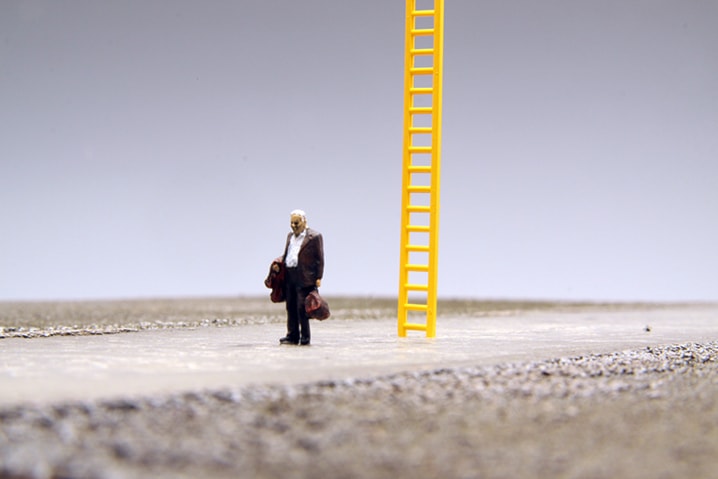Jason Frizzell’s detailed psychological landscapes wouldn’t be out of place in a Mad Max movie.
“Post-apocalyptic” is how the Red Deer artist describes the sparse environments he’s created in five table-top sculptures exhibited as part of Future Station, the Art Gallery of Alberta’s 2015 Biennial of Contemporary Art in Edmonton.
The small-scale industrial buildings in these works, displayed at the University of Alberta’s Enterprise Square Gallery, at 10230 Jasper Ave., look distressed and stained.
The tiny people in Frizzell’s dioramas seem to personify alienation. They stand separated by space or — in one case, a vast chasm.
Whatever action takes place in these tableaus plays out in an atmosphere of austerity and desolation.
But even though his art about psychological dilemma has autobiographical overtones, Frizzell insists he’s not an unhappy guy — just someone who likes the look of decomposition, “rot and crumble.”
“I’m attracted to muted colours, sparse spaces ... and distressed surfaces that are not clean looking and are covered in moss,” he said.
These aesthetics happen to fit with his themes of “isolation, transition, denial and discovery.” But “my work comes across as darker than my personality is,” maintains the artist, with a chuckle.
Frizzell, who heads the School of Creative Arts at Red Deer College, used to sculpt on a large scale, as a sense of space was always integral to his creations.
For practical purposes, he decided to shrink the size of his sculptures, but not the scope of his subject matter. His weighty themes might resonate with anyone who’s struggled with personal emotions or instincts.
In If You Don’t Want to Know, Don’t Ask, two tiny men stand a great distance apart, facing different directions. Between them is a yellow ladder going straight up.
While Frizzell doesn’t like to spell out solutions to questions posed by his pieces, he reveals that ladders symbolize transition or an opportunity. In this case, the two men could be interpreted as representing two conflicting halves of the same personality, or two aspects of behaviour that have had to diverge.
There’s also a sense of duality in 364, a diorama in which two identical men stare at each other across a crevasse. Frizzell said the title refers to the 364 days a year when people are not imbued with the warmth and good will of the Christmas spirit.
Another psychological quandary is suggested in Neither the Courage Nor the Faith, in which the figure of a man stands on top of a vertical rise. He has no means of getting down. Meanwhile, the top of a ladder is seen coming out of a hole in the ground far below — so if there’s an easy solution to the figure’s problem, it doesn’t seem forthcoming.
Among the more nebulous of Frizzell’s works is The House on Starting Over Street, which features a glass-topped structure filled with “zombie-like” people. Outside is a vast unkempt yard with two naked figures — male and female — standing a good distance apart. The viewer’s attention is drawn to this couple, but it’s unclear if they are coming together or being pulled asunder.
“I try not to make it too directed a narrative,” said Frizzell, who was inspired to create this scene by a real-life event. “It’s a portrait of someone close to me who was ending a relationship. ... There’s a bit of an expulsion from the garden theme.”
Also intriguing is I Looked in the Back So I Know How It Ends, which shows a naked man cornered at a wire fence by approaching figures in haz-mat suits. A distinctive building on stilts is situated on one side of this action — Frizzell pulled this structure from a re-occurring dream he’s had since he was a child.
While he never built models as a boy, he now uses store-bought model kits to help create the dioramas that illustrate internal landscapes. The kits are only a starting point, said Frizzell, who elaborates on the designs, or combines different elements to achieve ideas that usually begin as drawings.
The Edmonton-born artist studied visual arts at Red Deer College, and the Universities of Calgary and Victoria. He said he always enjoyed drawing while growing up in Red Deer, and was later encouraged to pursue art by his supportive family — including an artistic grandfather, who painted Western scenes.
While Frizzell makes his home on the Prairies, he believes the bleak spaces portrayed in films like Mel Gibson’s The Road Warrior are what really sparked his artistic imagination.
He hopes viewers will bend down while looking at his sculptures, so their eyes are level with his tiny people. This way viewers can experience the strange worlds his figures inhabit “as a bit of a surrogate.”
Future Station continues to May 3.
Other Red Deerians with work in the show are multi-media artist and RDC instructor Robin Lambert and photographer Nicole Kelly Westman.
lmichelin@www.reddeeradvocate.com
